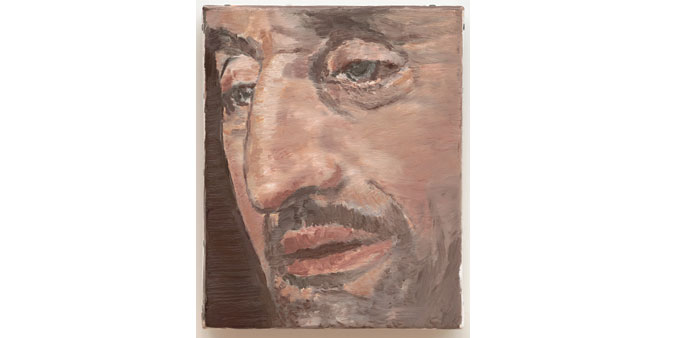Belgian artist Luc Tuymans’s first solo show in the Gulf, hosted by
Qatar Musems, traverses 30 years of his work. By Anand Holla
At the massive Al Riwaq that sits near the Museum of Islamic Art, a spectacular retrospective by Belgian artist Luc Tuymans effortlessly enthrals the steady stream of visitors with its sheer scale and range, let alone the content.
For the celebrated figurative painter widely credited with having contributed to the revival of painting in the 1990s, Qatar Museums’ (QM) showcasing of his first solo show in the Gulf – it opened last week and will continue till January 30, 2016 – is a mega project that courses through 30 years of his work.
With Tuymans’ exhibition Intolerance packing in a long series of wall paintings and a new body of work, The Arena, created specifically for the show, it’s imperative that there be a cool catalogue to guide us through it.
The in-depth, exhaustive catalogue titled Luc Tuymans: Intolerance – available at the venue, and also as a digital edition through musebooks.com – is published on occasion of the exhibition. Put together by Curator Lynne Cooke and Tommy Simoens, this 465-page catalogue is a definitive companion to viewing the artist’s works. We give you a quick run through a few bits.
At one point, Tuymans reveals, “The influence of D W Griffith’s 1916 silent film Intolerance was very much the map that guided the foundational and organising principles that are at the heart of this exhibition. Lynne, Tommy, and I assembled this show almost as an editorial exercise — using paintings and bodies of work —based on that film.”
In a conversation that he has with Tuymans, Sheikh Jassim bin Abdulaziz al-Thani asks the artist what he makes of Qatar’s architecture in relation to the well-known architecture elsewhere.
Tuymans responds, “Apart from being so contemporary, innovative, and rapidly developed, one striking characteristic here in Qatar is the amazing sense of spatial context. There is a tremendous generosity with which the buildings and their settings are designed, considering the enormous amount of space around and between the buildings. At times it seems that there’s nearly a football field of space — or more — between them.”
Continues Tuymans, “When you visit old cities around the world, this is often not the case. In fact, New York City especially is the exact opposite. And in China, where there has also been a great deal of development, you see cities that have been so fully built up that they have become all closed in. I think the history of the Western approach to architecture stems from its history of images, which, of course, is rooted in religion.”
In his piece, Nicholas Serota points out how Tuymans has become celebrated as a painter whose images reflect the traumas generated by some of the most shameful episodes in recent history: the Holocaust, the aftermath of colonial rule, 9/11, and the invasion of Iraq.
“In a Tuymans exhibition the paintings stimulate our curiosity, command our attention, and, above all, provoke an emotional response, long before we read the label and the title that gives us a clue as to their subject. Paradoxically, for a painter whose mastery of light is one of his distinguishing strengths, these emotions are invariably emotions of darkness,” Serota observes.
Art historian Nicholas Cullinan opines that much of Tuymans’ work seems to question the notion of any hierarchy of images. “This is evident in his simultaneous engagement with – and subversion of – the five classical genres of painting (history painting, portraiture, genre painting, landscape, and still life), and also in where Tuymans gathers images from and how he mediates them,” Cullinan says.
One of the remarkable things about Tuymans is how seamlessly he has adopted technology. As Cullinan explains, “Whereas Tuymans’ earlier paintings were more often based on photographic images culled from magazines, newspapers, or film and television stills, the artist presently relies on digital images found on the internet or shot with his own camera phone.”
Speaking of camera phones, one of Tuymans’ works titled Iphone (2008) refers to the source of this unrecognisable self-portrait – one of many anonymous portraits in Tuymans’ oeuvre. Its description in the catalogue says, “Tuymans’ attempt to photograph his own shadow, as it appeared against a wall, occasions its enigmatic transformation into a prismatic silhouette. A white glow limns the multihued form, creating a faint halo effect. The ethereal image, reminiscent of spiritualist or aura photography, is rendered in luminous, dappled brushstrokes.”
In this work, Tuymans foregrounds the substance and limits of his source material. “Here, he extends his ongoing exploration of the mediated relationship between painting and other types of images to the explicitly digital realm. The obscurity of the portrait belies our expectations of photographic technology. Traditional analogue photography is usually singled out for its indexicality: like a shadow, a photograph testifies to the reality of its subject. In Iphone, this relationship is made ambiguous. The limits of digital technology become part of the image; it is indissoluble from the artist’s visage as it is converted – and converted again – into pixels, then brushstrokes,” the note says.

The Nose, 2002. Oil on canvas.
